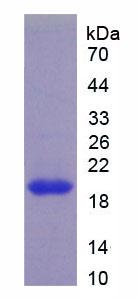Active Vitamin D Receptor (VDR) 

NR1I1; Nuclear Receptor Subfamily 1 Group I Member 1; Calcitriol Receptor; 1,25-dihydroxyvitamin D3 receptor
- UOM
- FOB US$ 312.00 US$ 780.00 US$ 1,560.00 US$ 4,680.00 US$ 11,700.00
- Quantity
Overview
Properties
- Product No.APA475Hu01
- Organism SpeciesHomo sapiens (Human) Same name, Different species.
- ApplicationsCell culture; Activity Assays.
Research use only - DownloadInstruction Manual
- CategoryMetabolic pathwayEndocrinology
- Buffer FormulationPBS, pH7.4, containing 0.01% SKL, 5% Trehalose.
- Traits Freeze-dried powder, Purity > 90%
- Isoelectric Point6.5
Sign into your account
Share a new citation as an author
Upload your experimental result
Review

Contact us
Please fill in the blank.
Activity test

Vitamin D Receptor (VDR) is the nuclear hormone receptor for vitamin D3. The receptor belongs to the family of trans-acting transcriptional regulatory factors and shows sequence similarity to the steroid and thyroid hormone receptors. It mediates the action of vitamin D3 by controlling the expression of hormone sensitive genes. Besides, Retinoid X Receptor Alpha (RXRa) has been identified as an interactor of VDR, thus a binding ELISA assay was conducted to detect the interaction of recombinant human VDR and recombinant human RXRa. Briefly, VDR were diluted serially in PBS, with 0.01% BSA (pH 7.4). Duplicate samples of 100 ul were then transferred to RXRa-coated microtiter wells and incubated for 1h at 37℃. Wells were aspirated and incubated for 1h with anti-VDR pAb, then aspirated and washed 3 times. After incubation with HRP labelled secondary antibody, wells were aspirated and washed 5 times. With the addition of substrate solution , wells were incubated 15-25 minutes at 37℃. Finally, add 50 µL stop solution to the wells and read at 450nm immediately. The binding activity of of VDR and RXRa was shown in Figure 1, and this effect was in a dose dependent manner. The EC50 for this effect is 0.469 ug/mL.
Usage
Reconstitute in 10mM PBS (pH7.4) to a concentration of 0.1-1.0 mg/mL. Do not vortex.
Storage
Avoid repeated freeze/thaw cycles. Store at 2-8°C for one month. Aliquot and store at -80°C for 12 months.
Stability
The thermal stability is described by the loss rate. The loss rate was determined by accelerated thermal degradation test, that is, incubate the protein at 37°C for 48h, and no obvious degradation and precipitation were observed. The loss rate is less than 5% within the expiration date under appropriate storage condition.
Increment services
-
 BCA Protein Quantification Kit
BCA Protein Quantification Kit
-
 Molecular Mass Marker for Protein
Molecular Mass Marker for Protein
-
 Monoclonal Antibody Customized Service
Monoclonal Antibody Customized Service
-
 Polyclonal Antibody Customized Service
Polyclonal Antibody Customized Service
-
 Protein Activity Test Experiment Service
Protein Activity Test Experiment Service
-
 Electrophoretic Mobility Shift Assay (EMSA) Experiment Service
Electrophoretic Mobility Shift Assay (EMSA) Experiment Service
-
 Buffer
Buffer
-
 Lentivirus Packaging Experiment Service
Lentivirus Packaging Experiment Service
-
 Adenovirus Packaging Experiment Service
Adenovirus Packaging Experiment Service
-
 Real Time PCR Experimental Service
Real Time PCR Experimental Service
-
 Spike RBD Protein (S-RBD)
Spike RBD Protein (S-RBD)
-
 Protein G
Protein G
-
 Protein A
Protein A
Citations
- The vitamin D receptor: A therapeutic target for the treatment of breast cancer?Cgi: Content
- Vitamin D receptor as a target for breast cancer therapy.pubmed:28213567
- Effect of exercise on serum vitamin D and tissue vitamin Dreceptors in experimentally induced type 2 Diabetes Mellitus.pubmed:27504197
- Vitamin D supplementation attenuates oxidative stress in paraspinal skeletal muscles in patients with low back painPubmed:29143122
- Enhanced remedial effects for vitamin D3 and calcium co-supplementation against pre-existing lead nephrotoxicity in mice: The roles of renal calcium homeostatic …Pubmed: 30553018
- Seluang Fish (Rasbora Spp.) Oil Decreases Inflammatory Cytokines Via Increasing Vitamin D Level in Systemic Lupus Erythematosus
- Status of vitamin D and the associated host factors in pulmonary tuberculosis patients and their household contacts: a cross sectional studyPubmed: 31255688
- Association of Fok1 VDR polymorphism with Vitamin D and its associated molecules in pulmonary tuberculosis patients and their household contactsPubmed: 31649297
- Vitamin D Status in Dupuytren's Disease: Association with Clinical Status and Vitamin D Receptor Expression
- Betok Fish (Anabas testudineus) Oil Decreases Inflammatory Cytokine through Increasing Vitamin D Level in Rats-induced Systemic Lupus Erythematosus
- Positive Correlation between Monocyte-to-Lymphocyte Ratio and C-Reactive Protein in Vitamin D Deficient Preterm Infants with Respiratory Distress Syndrome
- Identification of SNP of VDR and VDBP gene and its Dysregulated pathway through VDR-VDBP interaction network analysis in Vitamin D deficient Infertile …








